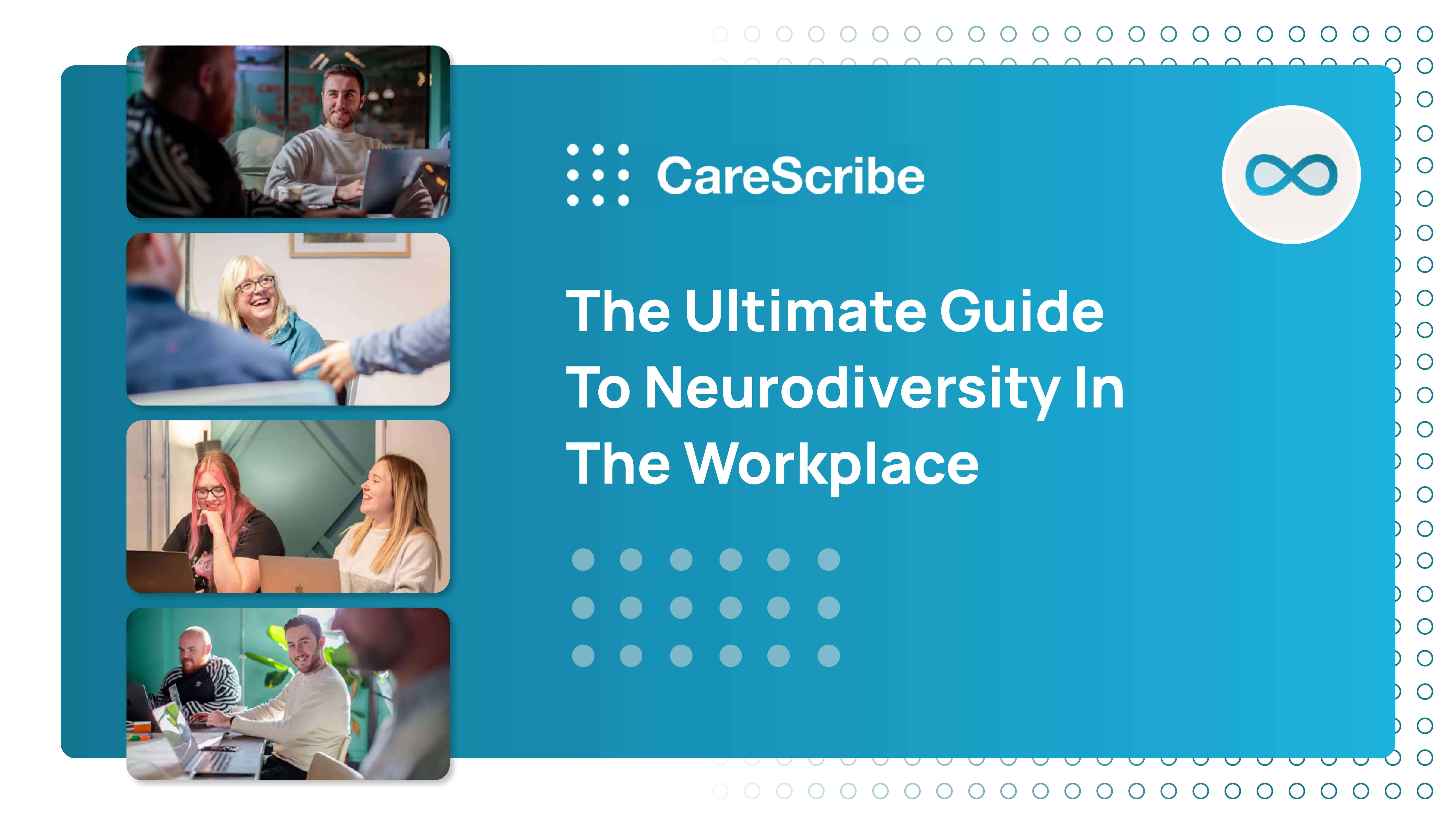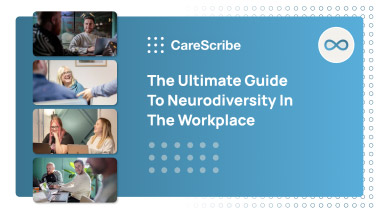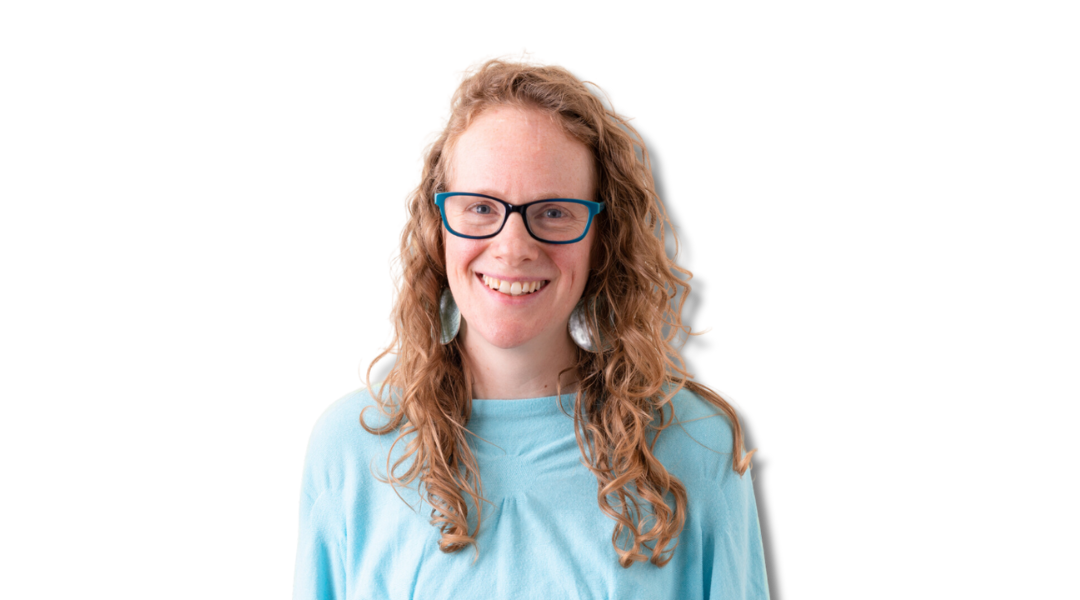The Ultimate Guide to Neurodiversity in the Workplace
Practical advice and information to help organisations of any size better support their neurodivergent people.

What is Neurodiversity in the Workplace?
Neurodiversity refers to the natural variation in how people’s brains work and process information. It includes a range of conditions like autism, ADHD, dyslexia, and more, each of which brings unique perspectives and abilities to the workplace. By embracing neurodiversity in the workplace, organisations can foster more inclusive, innovative teams that leverage the strengths of each individual.
Global organisations are increasingly recognising the benefits of supporting neurodiversity in the workplace. And the progress they’ve made has inspired us to produce this guide. Through well-researched, detailed information and practical advice, this ebook aims to support organisations of all sizes to better promote neurodiversity in the workplace. Featuring a comprehensive outline of the definitions of neurodivergence, this guide offers suggestions on how to improve workplace neurodiversity in a variety of contexts, such as the Access to Work scheme or examples of reasonable adjustments. And while our intentions are well-placed, we acknowledge that lasting change regarding neurodiversity in the workplace isn’t a straightforward or simple process.
Removing Barriers for Neurodivergent Employees
A report by the Harvard Business Review revealed how typically displayed behaviours of neurodiverse people can run counter to common notions of what makes a good employee. Often, hiring panels look for salesman-like personalities, networking skills, and the ability to follow processes without extra support or accommodation. But these assumptions can result in unfair judgements or instances where hiring panels overlook the potential benefits of hiring neurodivergent candidates. For existing staff with an undiagnosed or undisclosed condition, negative workplace assumptions often prevent disclosure, blocking access to work support schemes and reasonable adjustments.
The Ultimate Guide to Neurodiversity in the Workplace
Without the appropriate tools to support them, people with autism, dyslexia, ADHD or even long-term depression will find it harder to bring their talents to work. A survey by Neurodiversity charity Neurodiversity in Business and Birkbeck University suggests 65% of employees fear managerial discrimination and a further 55% worry they’ll face discrimination from peers. Neurodivergent staff need to feel safe disclosing their challenges and much of this lies in creating positive workplace environments that prioritise neurodiversity in the workplace.
We recommend workplace diversity leaders–at all levels and in all contexts–review this ebook and consider the steps they can take to support neurodiversity in the workplace. And while we’re not suggesting any of this is simple, easy, or straightforward, our aim is to inspire you to consider the benefits of promoting neurodiversity at work and present a number of ways to encourage it.
At Carescribe, we know that leveraging the skills of neurodivergent staff leads to competitive advantages and that’s why we’re committed to designing tools such as Caption.Ed and TalkType. So, while we can’t claim to have our house completely in order yet, we can say that we’re committed to positive change both for employees and for business outcomes.

The Ultimate Guide to Neurodiversity in the Workplace
Why It’s Important to Support Neurodiversity in the Workplace
Modern businesses often struggle with facilitating neurodiversity in the workplace, leaving neurodivergent employees feeling unsupported. Employees don’t feel safe to disclose and employers are making assumptions about skill sets. Neurodivergent staff don’t feel safe or supported, while employers lack neurodiversity training to expand their knowledge and build the confidence needed to improve the situation. Also, workplace cultures can defer to stereotypes and assume neurodivergent staff don’t have the desirable, people-oriented skill sets they would expect from staff like networking and persuasiveness.
When staff don’t feel confident to disclose their condition, due to fear of stigma or lack of support, they can feel invisible. In some cases, this can lead to higher staff attrition and damaged employer brands. In more extreme instances, employers can face costly legal fees. And Fox & Partners LLP confirms that the number of employment tribunals citing neurodiversity discrimination rose by a third between 2020 and 2021.
How supporting neurodiversity at work benefits organisations
Providing reasonable adjustments and giving neurodivergent staff the support they need to work to their full potential is important. But there are also many benefits of promoting neurodiversity in the workplace for organisations, employers, and team members.
- Higher rates of productivity: The Harvard Business Review said neurodivergent staff can achieve 30% better productivity compared to their neurotypical peers, showing the potential value of promoting neurodiversity at work.
- Creativity, innovation, imagination, and ideation: A survey by Neurodiversity in Business and Birkbeck University showed 80% of neurodivergent staff with skills in hyperfocus, 78% in creativity, 75% in innovative thinking, and 71% with detail processing skills.
- Data visualisation and computational thinking skills: Sparta Global’s 2023 EqualTech report on neurodiversity showed how employees with autism achieve above-average results in machine learning and quantum computing, highlighting neurodiversity in business can be an asset.
- Reduced attrition rates: The report by Neurodiversity in Business also showed how employees are 50% less likely to leave a workplace when adjustments are tailored to their needs.
- Improved Employee Value Proposition: GCHQ advertises positions for neurodiverse females to ensure a diverse mix of minds. They say this is crucial for code cracking, reviewing threats and minimising the predictability of UK security systems.
- Hire from a wider candidate pool: Advertising for neurodiverse talent is an active way to widen your candidate pool and select from a wider range of high-calibre candidates. Very often, neurodivergent candidates will have perspectives that others may not have thought of before. Hiring them can realise their untapped potential while adding significant value to teamwork, operations, and project outcomes.
How supporting neurodiversity at work benefits teams and employees
- Increased focus, observation, and problem-solving: Neurodivergent staff often show higher potential for problem solving. Sparta Global’s report highlights how employees with these traits drive new developments in robotics and augmented reality.
- Empathy and intuition: According to CIPD, autistic people often feel very deep emotions but find it difficult to express them. This can enhance teamwork and lead to more supportive environments.
- Authenticity and adaptability: Increasing visibility for neurodivergent staff can help disarm other team members and allow everyone to bring more of themselves and their talent to their roles.

“In order to benefit from the power of neurodiversity, organisations need to create a safe and supportive environment for neurodivergent employees. Neuro-affirmative attitudes, a shift in mindset towards the social model of disability and an inclusive culture are critical to enable this”
Jessica Meredith
CEO and Founder, Differing Minds
What is Neurodiversity?
Understanding neurodiversity in the workplace and recognising the differences between different types of neurodiversity is crucial for fostering an inclusive environment. Neurodivergent individuals do not all display the same attributes. And while the term is helpful to highlight problems, it can also be unhelpful when explaining the different types of neurodiversity and thinking styles.
So, let’s clarify the terms we’re using and the differences between each type of neurodivergent thinking.
Neurodiversity Definitions
Neurodiversity: A catch-all term that describes groups of individuals who show different ways of thinking. In practice, neurodiversity includes individuals with divergent ways of thinking, such as individuals with autism, dyslexia, and ADHD, for example. But these groups should also include individuals who don’t have diagnosable differences in thinking. Organisations that support neurodiversity will have a workplace that contains both employees with and without diagnosed disabilities.
Neurodivergence: This refers to individuals who have thinking patterns that the majority of people consider different. Specifically, neurodivergent individuals will have a diagnosed disability relating to the way they process information.
Neurotypical: Neurotypical individuals are people who show thinking patterns that fit within societal expectations. They do not have a diagnosable disability nor do they show indications of a disability.
Neurominority: These are groups of neurodivergent individuals who share a similar form of neurodivergence. When using the word ‘Neurominority’ it should be assumed to be a group of individuals with the same type of neurodivergence.
Neurospicy: A modern, lighthearted term gaining popularity online, especially within the neurodivergent community. It’s often used to describe people with neurodivergent symptoms in a fun, engaging way.

These Great Minds 🧠
Learn more about our monthly newsletter for neurodiverse professionals
Neurodiversity Stereotypes
A key point to note is how easy it can be to stereotype neurodivergent individuals and make assumptions on the potential for shared characteristics. In a 2016 study, The National Institute of Economic and Social Research–Britain’s oldest independent economic research institute–explained how there is a ‘propensity for neurodivergent individuals to be stereotyped according to the more well-known characteristics of their condition’. And since we want to avoid stereotyping and be more precise about the differences between neurodivergent conditions, let’s get into more detail before we describe each type and subtype of neurodiversity.
In recent years, new ways of thinking have uncovered the possibility that we may be wrong to assume humans have a ‘typical’ way of thinking. Instead, several academics suggest neurodiversity may be biological phenomena to embrace.
In his 2015 paper ‘The Myth of the Normal Brain: Embracing Neurodiversity’, Thomas Armstrong, Professor at the University of La Verne, highlights the absence of any standard model of a normal brain to compare neurodivergent thinking to. And he explains that the ‘three dimensional’ way of thinking in some people with dyslexia may have been an adaptive measure in preliterate cultures. In effect, he suggests people with dyslexia may have evolved to pioneer innovations such as tool design, shelter construction, and plotting hunting routes.
The Neurodiversity Paradigm and Neurodiversity Movement
Further to this thinking is ‘The Neurodiversity Paradigm’ and the subsequent neurodiversity movement. Defined by autistic scholar Nick Walker, PhD., the Neurodiversity paradigm acknowledges how neurological diversity benefits the richness of the human species. But rather than refer to people as either normal or abnormal, the words ‘neurotypical’ or ‘neurodivergent’ would be better descriptors.
The Ultimate Guide to Neurodiversity in the Workplace
The Neurodiversity Movement originates from the Autistic Rights Movement which emerged in the 1990s. Australian sociologist Judy Singer coined both this phrase and, in fact, the term ‘Neurodiversity’ in a 1998 thesis. An associate in the Department of Philosophy at the University of Bristol, Robert Chapman PhD, has taken this a step further. They define it instead as a social justice movement that’s moving away from the default approach and making mental, developmental, and cognitive disability not one of pathology but towards what they call a ‘social ecological’ approach which promotes pride, inclusion, and acceptance, akin to what’s seen in the LGTBQ+ movement.
Types of Neurodiversity
It can be overwhelming in itself to consider the broad range of neurodiverse conditions and how these can impact people at work. One way to manage this is by grouping conditions into broader categories. According to the Neurodiversity Working Group at the UK College of Police, three categories can help to segment different types of neurodiversity, i.e. Applied, Clinical and Acquired.
Applied Neurodivergence
Applied Neurodivergence refers to a condition that someone is born with but isn’t a pathological condition or health condition. Instead, Applied Neurodivergent conditions are innate, genetic differences, and someone’s natural state. People with Applied Neurodivergence may find it difficult to use certain cognitive skills like reading, writing, gross motor control, and numerical cognition. But it’s important to note that Applied Neurodivergence occurs across a full range of intellectual abilities.
Examples of Applied Neurodivergence conditions include:
- Dyslexia: People with dyslexia have a different way of learning and processing information from neurotypical individuals. Dyslexia affects accuracy and fluency with word reading and spelling. It can also impact phonological awareness, verbal memory, and verbal processing.
- Dyspraxia: Also known as Developmental Coordination Disorder (DCD), dyspraxia affects movement and specifically fine and/or gross motor coordination. People with dyspraxia can also have problems with organisation, and speech and language. They may find it harder to keep up with conversations and can have difficulty with attention or memory.
- Dyscalculia: People who have dyscalculia have a specific difficulty with processing and understanding numbers. And this can lead to problems with mathematics. Also referred to as Developmental Dyscalculia (DD), people with dyscalculia struggle with number sense, memorising arithmetic facts, and showing fluency with calculation.
- Dysgraphia: Dysgraphia affects fine motor skills and shows up as distorted or incorrect writing. It can affect all aspects of writing from legibility to word spacing, spelling to general expression. But it can also show up as problems with spatial perception or even having a tight grip on a pen or pencil.
- Others: Other conditions beyond the four we’ve mentioned include:
- Synesthesia: People with synesthesia use blended senses. They can describe visualising music as colours or tasting shapes.
- Colour Blindness: People who are colour blind can’t experience the sight of colours in a neurotypical way. It can be a genetic and an acquired phenomenon.

“Organisations benefit from the tangible and real-world strengths and abilities to build a neuroinclusive, disability-friendly culture where everyone can thrive. Whilst every individual is unique, there are many reported in-demand skills such as lateral thinking, problem-solving, connecting seemingly disparate ideas, attention to detail, hyper-focus, empathy, and relationship-building, among others”
Dr Deborah Leveroy
Head of Consultancy & Research, neurobox
Clinical Neurodivergence
Clinical Neurodivergence refers to people born with a neurological difference that is also considered a health condition. So while the term refers to innate differences, a person with ‘Clinical Neurodivergence’ will find they have difficulties in communication, behaviour, and social skills.
Examples of Clinical Neurodivergence conditions include:
- Autism Spectrum Condition (ASC): Autism Spectrum Condition (ASC) is a neurological condition and a developmental condition. It affects how people behave and communicate. Individuals with ASC can have specific, restricted interests and repetitive behaviours. They may also have delayed language, movement, or cognitive and learning skills. Specific types of ASC include:
- Level 1 ASC / Asperger Syndrome: ASC is a spectrum and people with Asperger syndrome don’t often have the same learning disabilities as other people with ASC. Asperger Syndrome may present as a Specific Learning Difficulty (SpLD)
- Classic Autistic Disorder / Kanner’s Syndrome: Symptoms can include communication difficulties, lack of eye contact, and hypersensitivity to stimuli.
- PDD-NOS / Pervasive Developmental Disorder / Atypical Autism: Individuals may show fewer or milder symptoms which can include challenges with social interactions and communication.
- Rett Syndrome: Rett Syndrome is a rare condition resulting in a loss of motor skills and language.
- Childhood Disintegrative Disorder (CDD): This is a rare disorder that results in a regression of skills such as language or motor skills.
- Attention Deficit Hyperactivity Disorder (ADHD): ADHD affects people’s behaviour. It’s marked by inattention and/or hyperactivity-impulsivity which can interfere with functioning or development.
- Inattention can include difficulties staying focused on a task or staying organised. It may mean people overlooking or missing details or avoiding tasks that require sustained mental effort.
- Hyperactivity may result in a person moving around a lot and in situations when it is not appropriate. They may be ‘always on the go’ or talk excessively.
- Impulsivity can manifest as a lack of appropriate self-control. An example could be interrupting others in the workplace or not thinking through the long-term consequences of actions.
- Intellectual and Psychiatric Disabilities, including Down’s Syndrome: Intellectual disabilities affect a person’s life across three categories: conceptual, social, and practical. This can show up as a lack of empathy, judgement of social norms, or self-care. And while Down’s syndrome is classed as an intellectual disability, people with the condition can and do contribute to the working world in many positive and productive ways.
- Tourette’s Syndrome: People with Tourette’s Syndrome suffer from involuntary body movements and noises referred to as ‘tics’. Tics can include eye rolling, blinking, jerking of head or limbs, touching objects, touching other people, grimacing and shoulder shrugging. People with vocal tics can also make noises like whistling, coughing, clicking, animal sounds or blurt out random or inappropriate words.
- Others: Other Clinical Neurodivergent conditions include Epilepsy and Cerebral Palsy.

The Ultimate Guide to Neurodiversity in the Workplace
Acquired Neurodivergence
Acquired Neurodivergence refers to changes in cognition and behaviour that emerge from a health condition or injury. These types of neurological differences have the potential to resolve as an injury or illness heals. In some cases, though, the neurological differences remain.
Examples of Acquired Neurodivergence conditions include:
- Bipolar Disorder, PTSD, OCD, depression, and anxiety: Acquired conditions include mental health disorders such as Post Traumatic Stress Disorder, Obsessive Compulsive Disorder, Bipolar Disorder, and depression and anxiety. Bipolar Disorder is one of the most common Acquired Neurodivergent conditions and it’s thought that around 1 in 50 people has the disorder. Research also suggests Bipolar Disorder exists on a spectrum, with around 5% of people existing on a spectrum.
- Traumatic brain injuries that alter cognition: Cognitive impairments can happen to individuals following traumatic brain injury and are fairly common. Impairments can impact memory and levels of attention while decreasing concentration and verbal or visual processing. The variety of impairments that follow brain injuries makes rehabilitation complex and sometimes difficult to achieve.
- Illnesses or treatments that limit cognition: Some health conditions and illnesses can also impact cognitive function. One example is the number of people who experience what’s known as ‘Brain Fog’ from illness, inflammation, or hormonal imbalances. Conditions that cause Brain Fog include diabetes, hypothyroidism, Multiple Sclerosis, menopause and perimenopause, vitamin deficiencies, and Long-Covid.
- Others: Other conditions which fall into this category include Borderline Personality Disorder (BPD) and Histrionic Personality Disorder (HPD). While people with BPD can have a genetic disposition, it’s thought that BPD is a result of problems with neurotransmitters in the brain like serotonin.
Sensory Processing Disorder (SPD)
Receiving a diagnosis for a neurodivergent condition can be life-changing. And it often brings with it a sense of relief and acceptance when those affected are able to explain their differences to others. But while Autism Spectrum Disorder, Dyslexia, and ADHD are considered formal diagnoses, these conditions can sometimes overlap with less recognised disorders, specifically Sensory Processing Disorder (SPD).
SPD is a neurological condition that disrupts the body’s ability to receive messages from its senses. It can prevent someone from filtering out less important sensory information such as background noises but also prevent them from acting on the messages they receive via sight, sound, touch, smell, and taste. Someone with SPD may become overwhelmed or triggered when lights are too bright or when they hear loud sounds like fireworks. SPD can be comorbid with other neurodivergent conditions and up to 60% of children with either ADHD or SPD will also show symptoms of the other condition.
Different types of SPD:
- Sensory Modulation Disorder (SMD): Impacts sensory processing across single or multiple sensory systems.
- Sensory Discrimination Disorder (SDD): This may occur across visual, auditory, tactile, smell, taste, vestibular, proprioception, and interoceptive senses.
- Sensory-Based Motor Disorder (SBMD): Affects balance and motor skills. Includes Postural Disorders and Dyspraxia.

These Great Minds 🧠
Learn more about our monthly newsletter for neurodiverse professionals
Is neurodiversity a disability?
Neurodiversity encompasses a range of neurological differences, including conditions such as dyslexia, ADHD, and autism. Under the Equality Act 2010, certain neurodivergent conditions are classified as disabilities, providing protection against discrimination.
For instance, dyslexia is recognised as a neurodivergent condition and is also categorised as a disability. This classification means that employees with dyslexia are entitled to reasonable adjustments in workplace settings to help them navigate challenges associated with their condition.
Neurodivergent Symptoms at Work
Understanding neurodivergent symptoms is crucial for fostering an inclusive workplace accommodating individuals with diverse cognitive profiles. Neurodivergent individuals may exhibit a range of symptoms that can impact their experience and performance in the workplace. Here are some common neurodivergent symptoms employees can exhibit:
- Attention Variability: Employees with ADHD may struggle to focus, leading to difficulty completing tasks within deadlines. However, many also can hyperfocus on tasks that genuinely interest them, showcasing their potential for high productivity when engaged.
- Communication Differences: Neurodivergent individuals, particularly those on the autism spectrum, may have unique communication styles. They might prefer direct, clear instructions and may find social interactions challenging. Understanding these differences can help create a supportive environment that values diverse communication methods.
- Sensory Sensitivities: Many neurodivergent employees experience heightened sensitivity to sensory stimuli, such as bright lights, loud noises, or certain textures. Providing a sensory-friendly workspace or allowing for adjustments can significantly enhance their comfort and productivity.
- Organisational Challenges: Conditions like dyslexia and dyspraxia can affect how individuals process information, impacting their organisational skills. Tools like assistive technology or structured workflows can help mitigate these challenges and empower neurodivergent employees to excel.

Inclusive Workplaces 🧩
Your go-to monthly newsletter for creating inclusive environments for neurodivergent talent in the workplace
How to Support Neurodiversity in the Workplace
Supporting neurodiversity in the workplace is essential for fostering an inclusive environment. It’s a powerful opportunity for organisations to unlock creativity, problem-solving, and innovation by embracing the diverse ways in which people think and process information. From making reasonable adjustments and encouraging to apply to the Access to Work scheme to enabling leadership, regardless of their size, organisations can create a culture that values neurodivergent individuals.
Whether you’re a small start-up or a large global corporation, supporting neurodivergent employees can create a more inclusive environment and improve business outcomes. In our guide, you will explore practical steps tailored for organisations of different sizes—small, medium, and large—to better support neurodiversity in the workplace.
Practical Steps for Small Organisations (<50 Employees)
Small organisations often face the challenge of having limited resources, but they also have the advantage of being agile and able to implement changes quickly. For small businesses looking to embrace neurodiversity, the first step is creating a culture of inclusion from the top down.
Make Reasonable Adjustments
As mandated by the Equality Act 2010, all UK companies must implement reasonable adjustments for any employee known to be disabled. This includes adjustments requested by neurodivergent staff who may experience difficulties at work. Promoting a culture of openness encourages staff to disclose their needs, ensuring they feel safe and supported.
The Ultimate Guide to Neurodiversity in the Workplace
Examples of Reasonable Adjustments:
- Provide flexible work hours or remote work options to accommodate varying attention spans and energy levels.
- Offer assistive technology, such as CareScribe’s Caption.Ed and TalkType, which are available through the Access to Work scheme.
- Create sensory-friendly workspaces to minimise distractions and enhance focus.
Promote the Access to Work Scheme
The Access to Work scheme is a valuable government-funded resource designed to support employees with specific needs. This scheme offers grants for equipment, mental health support, or other necessary support, ensuring that neurodivergent individuals have the tools they need to succeed. It’s important to note that a formal diagnosis is not required to access these resources. CareScribe’s assistive technologies can be obtained through this scheme, providing essential support for neurodiverse employees.
Support Neurodiversity Celebration Week
Participating in Neurodiversity Celebration Week, held annually in March, is a proactive way to demonstrate commitment to neurodiversity at work. Engaging in activities and sharing on social media raises awareness and encourages conversations about the importance of supporting neurodivergent staff. Involving leadership in relevant discussions during Neurodiversity Celebration Week can further amplify your organisation’s commitment to inclusion.
In our guide, you can find more practical strategies for small-sized organisations to support neurodiversity in the workplace.
Practical Steps for Medium Organisations (50-250 Employees)
Medium-sized organisations often have the resources to implement more structured neurodiversity programs, but they may still struggle with balancing various initiatives. Here are some strategies to effectively support neurodiversity in the workplace.
Appoint Neurodiversity Champions
One of the most effective ways for medium-sized organisations to promote neurodiversity in the workplace is by appointing Neurodiversity Champions. These champions can be individuals from any level within the company but should have the ability to influence senior management. Their role is to act as a point of contact for neurodivergent employees, provide support, and ensure that initiatives around neurodiversity are progressing as planned.
Facilitate Support Networks
Our monthly newsletter help neurodiverse professionals
Larger companies often employ more neurodivergent individuals, but some may choose not to disclose their conditions. Medium-sized organisations can create support networks where neurodivergent employees feel safe discussing their challenges and finding solutions. These networks also help identify areas for improvement and boost employee performance. An example of a successful network is the Civil Service Dyslexia and Dyspraxia Network, which provides a toolkit for line managers to support staff with these conditions.
Offer neurodiversity training for managers
Implementing neurodiversity training for managers is crucial for fostering understanding and empathy within teams. Training can equip leaders with the knowledge to recognise neurodivergent symptoms and make effective, reasonable adjustments. Neurodiversity training not only supports neurodiverse employees but also cultivates a more inclusive workplace culture.
In our guide, you can explore more practical strategies for medium-sized organisations to support neurodiversity in the workplace.

The Ultimate Guide to Neurodiversity in the Workplace
Practical Steps for Large Organisations (>250 Employees)
For larger organisations, the focus shifts to scaling neurodiversity initiatives, normalising inclusion at all levels of the business, and leading by example within the broader industry. Larger companies have more resources and can implement strategic programs that have a lasting impact on neurodiversity inclusion.
Host Events and Promote Best Practices
Hosting neurodiversity-inclusive events is an excellent way for large organisations to showcase their commitment. These events should be accessible to neurodivergent employees and highlight the positive adjustments made to improve inclusion, productivity, and innovation. Not only do these events benefit current employees, but they also set a benchmark for other organisations, role-modelling best practices for supporting neurodiversity in the workplace.
Normalise Neurodivergence Across the Organisation
Want to Know More About Our Products?
One of the most powerful tools large organisations can use to support neurodivergent employees is assistive technology. Offering site-wide licenses for software that helps neurodivergent individuals, such as speech-to-text tools or screen readers, benefits not only neurodivergent staff but also neurotypical employees who may also find these tools useful. By normalising neurodivergence and providing tools that assist all employees, companies can create a truly inclusive environment.
Join Global Initiatives and Set Targets
Global initiatives like Generation Valuable offer large companies access to tailored training programs designed for C-suite executives. Participating in such programs not only supports leadership development but also demonstrates a company’s commitment to disability inclusion. Additionally, setting neurodiversity-related targets and reporting progress regularly in company documents such as annual reports helps to normalise neurodiversity, reduce stigma, and improve business outcomes.
In our guide, you can discover more practical strategies for large-sized organisations to support neurodiversity in the workplace.
Bibliography
Aftab, A. (2021, September 24). The Neurodiversity Paradigm in Psychiatry: Robert Chapman, PhD. Psychiatric Times. https://www.psychiatrictimes.com/view/neurodiversity-paradigm-psychiatry
Armstrong, T. (2015). (PDF) The Myth of the Normal Brain: Embracing Neurodiversity. ResearchGate. https://www.researchgate.net/publication/275361818_The_Myth_of_the_Normal_Brain_Embracing_Neurodiversity BDA. (2022, September 22). Dyslexia Awareness Week 2022. British Dyslexia Association.
https://www.bdadyslexia.org.uk/news/dyslexia-awareness-week-2022-2
Bipolar UK. (2014, October 1). Bipolar – The Facts. Bipolar UK.
https://www.bipolaruk.org/faqs/bipolar-the-facts
CDC. (2022, December 9). What is Autism Spectrum Disorder? – ASD Diagnosis, Treatment, and Services. CDC. https://www.cdc.gov/ncbddd/autism/facts.html
Cerebral Palsy UK.
http://www.cerebralpalsy.org.uk/
ciccolella, f. (2021). Disability 100 Findings Report. The Valuable 500.
https://www.thevaluable500.com/wp-content/uploads/2021/07/Tortoise-Disability-100-Report-Valuable500-accessible.pdf
Disability pay gaps in the UK: 2021. (2022, April 25). Office for National Statistics.
https://www.ons.gov.uk/peoplepopulationandcommunity/healthandsocialcare/disability/articles/disabilitypaygapsintheuk/2021 Doğan, E., Healey, O., Moon, L., & Gordon, C. (2022). Co-Designing a More Inclusive Workplace: Thinklab-BBC CAPE Neurodiversity Project. Apollo – University of Cambridge Repository. https://www.repository.cam.ac.uk/items/3fc9f0f8-b381-4a71-9ff8-121ae5a06cf0 Epilepsy Action. (2023, January 17). UK epilepsy prevalence and incidence update. Epilepsy Action.
https://www.epilepsy.org.uk/uk-epilepsy-prevalence-and-incidence-update
Ferrie, B. (2022, March 10). What is dyscalculia and how can it be spotted and supported in children and adults? National Numeracy. https://www.nationalnumeracy.org.uk/news/what-dyscalculia-and-how-can-it-be-spotted-and-supported-children-and-adults Fox and Partners LLP. (2022, May 3). Employment tribunal claims relating to neurodiversity discrimination jump by a third in past year – Employment Law Specialists. Fox & Partners.
https://www.foxlawyers.com/employment-tribunal-claims-relating-to-neurodiversity-discrimination-jump-by-a-third-in-past-year/ GOSH NHS Trust. (2018). Tourette syndrome. Great Ormond Street Hospital.
https://www.gosh.nhs.uk/conditions-and-treatments/conditions-we-treat/tourette-syndrome
Greater Manchester Combined Authority. (n.d.). Delivering Effective Services for – Children and Young People with ADHD. NHS England. https://www.england.nhs.uk/north-west/wp-content/uploads/sites/48/2019/03/GM-wide-ADHD-guidance.pdf Harris, D. (2023, March 22). Neurodiversity: the power of thinking differently. ICAEW.com.
https://www.icaew.com/insights/viewpoints-on-the-news/2023/mar-2023/neurodiversity-the-power-of-thinking-differently
High Lantern Group for Bank of America. (2023). Neurodiversity in the workplace: Building toward a more inclusive future of work. business.bofa.com. https://business.bofa.com/content/dam/flagship/workplace-benefits/id20_0905/documents/neurodiversity.pdf Jolly, J. (2022, November 16). Neurodivergent women sought for jobs at GCHQ and BAE Systems. The Guardian. https://www.theguardian.com/society/2022/nov/16/neurodiverse-women-sought-for-jobs-at-gchq-and-bae-systems Maeda, N., & Heyne, D. (2015, December 22). Developmental Dyslexia and Dysgraphia: What can We Learn from the One About the Other? Frontiers.
https://www.frontiersin.org/articles/10.3389/fpsyg.2015.02045/full
Mahoney, J. (n.d.). J.P. Morgan Autism at work. Vercida’s.
https://resources.vercida.com/jpmorgan-autism-at-work
McDowall, A., Doyle, N., & Kiseleva, M. (2023). Neurodiversity at Work 2023: Demand, Supply, and a Gap Analysis [Birkbeck University and Neurodiversity in Business]. neurodiversityinbusiness.org. https://neurodiversityinbusiness.org/research/
National Autistic Society. (n.d.). Asperger syndrome (Asperger’s). National Autistic Society.
https://www.autism.org.uk/advice-and-guidance/what-is-autism/asperger-syndrome
Nelson, J. (2018, February 6). Neurodiversity at work – Guide. CIPD.
https://www.cipd.org/globalassets/media/knowledge/knowledge-hub/guides/neurodiversity-at-work_2018_tcm18-37852.pdf Neurodiversity Working Group – College of Policing. (2021, June 10). Neurodiversity glossary of terms. College of Policing. https://www.college.police.uk/support-forces/diversity-and-inclusion/neurodiversity-glossary-terms
Nouraeinejad, A. (2022, November 24). Brain fog as a Long-term Sequela of COVID-19. NCBI.
https://www.ncbi.nlm.nih.gov/pmc/articles/PMC9685075/
PwC’s Global Workforce Hopes and Fears Survey 2022. (2022, May 24). PwC.
https://www.pwc.com/gx/en/issues/workforce/hopes-and-fears-2022.html
Queen Mary University of London. (n.d.). What is Dyspraxia? – Disability and Dyslexia Service. Disability and Dyslexia Service. https://dds.qmul.ac.uk/dyslexia/whatisdyspraxia/
Raemason, S. (2022, January 28). Job opportunities for those with Down’s syndrome provided by Teddington based company. South West Londoner.
https://www.swlondoner.co.uk/life/28012022-job-opportunities-for-those-with-downs-syndrome-provided-by-teddington-based-company Rodden, J. (2023, January 21). What Is Sensory Processing Disorder: Related Questions. ADDitude.
https://www.additudemag.com/what-is-sensory-processing-disorder/
Ruiz, M. (2015, May 26). Intellectual Disability and Psychiatric Comorbidity: Challenges and Clinical Issues. Psychiatric Times. https://www.psychiatrictimes.com/view/intellectual-disability-and-psychiatric-comorbidity-challenges-and-clinical-issues Russell, G., Stapley, S., Newlove-Delgado, T., Salmon, A., White, R., Warren, F., Pearson, A., & Ford, T. (2021, August 19). Time trends in autism diagnosis over 20 years: a UK population-based cohort study. PubMed. https://pubmed.ncbi.nlm.nih.gov/34414570/ Topping, A. (2023, January 13). ADHD services ‘swamped’, say experts as more UK women seek diagnosis. The Guardian. https://www.theguardian.com/society/2023/jan/13/adhd-services-swamped-say-experts-as-more-uk-women-seek-diagnosis Valuable 500. (n.d.). Reporting. The Valuable 500.
https://www.thevaluable500.com/our-work/reporting
Vaughan, C. (2022, October 26). HR in Review 33 – How can you celebrate neurodiversity within the workplace? with Andrew Jones. HRreview. https://www.hrreview.co.uk/podcasts/hrinreview-public/hr-in-review-33-how-can-you-celebrate-neurodiversity-within-the-workplace-with andrew-jones/146891
Williams, K. (2023, April 21). The Link between Dyslexia and Entrepreneurial Success. Dyslexia UK.
https://www.dyslexiauk.co.uk/the-link-between-dyslexia-and-entrepreneurial-success/



